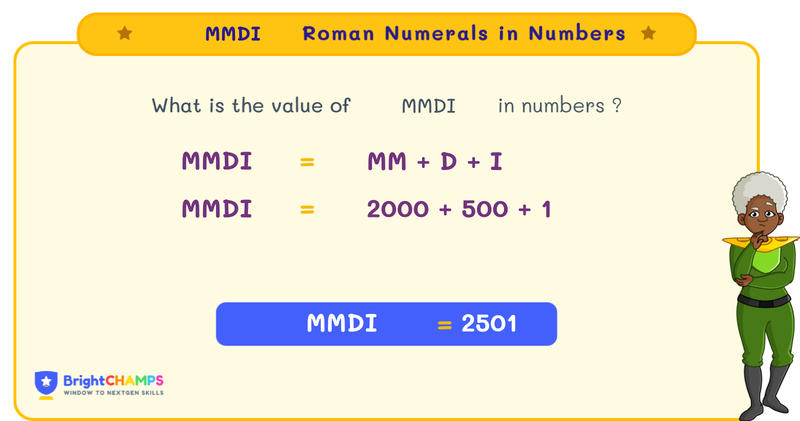Summarize this article:
 206 Learners
206 LearnersLast updated on August 5, 2025
MMDI in Roman Numerals

To meet their daily commerce and administration needs, the ancient Romans developed Roman Numerals. It used a combination of seven symbols — I, V, X, L, C, D, and M to represent numbers. Roman numerals were used to record transactions, keep track of data, and label military units. In this topic, we are going to learn about the Roman numeral MMDI.

What is MMDI in Roman Numerals?
Ancient Romans discovered that counting fingers could get very complicated after 10. So to overcome the complexity, the Roman numeric system was developed. This was widely used throughout Europe as a standard writing system until the late Middle Ages.
Seven symbols are used to represent numbers in the Roman numeric system — I, V, X, L, C, D, and M. The numerals are made up of different combinations of these symbols. MMDI in Roman numerals can be written in number form by adding the values of each Roman numeral, i.e., MMDI = 2501.
Let us learn more about the Roman numeral MMDI, how we write them, the mistakes we usually make, and ways to avoid these mistakes.

Basic Rules for MMDI in Roman Numerals
When writing Roman numerals, there are a few rules that we need to follow based on the Roman numerals we are trying to write. In this section, we will learn about the rules when writing Roman numerals and how to represent them.
Rule 1: Addition Method:
When a larger symbol is followed by a smaller symbol, we add the numerals to each other. For example, in VIII, we have 5 + 3 = 8.
Rule 2: Repetition Method:
A symbol that is repeated three times in continuation increases the value of the numeral. For example, XXX = 30.
Rule 3: Subtraction Method:
We use the subtraction method when a larger symbol follows a smaller symbol. For example, XL = 40 (which is 50 – 10).
Rule 4: Limitation Rule:
Symbols cannot be repeated more than three times, and some symbols, such as V, L, and D, cannot be repeated more than once. For example, 10 is represented as X and not VV.

How to Write MMDI in Roman Numerals?
Let us learn about how to write MMDI in Roman numerals. There are two methods that we can use to write Roman numerals:
- By Expansion Method
- By Grouping Method
Explore Our Programs



MMDI in Roman Numeral by Expansion Method
The breaking down of Roman numerals into parts and then converting them into numerals is what we call the expansion method. The expansion method is the breaking down of Roman numerals into numerical form and adding them to get the final number.
Step 1: Break the Roman numerals into parts.
Step 2: Now write each of the Roman numerals with its numerical digit in the place value.
Step 3: Add the numerals together.
For MMDI,
Step 1: First, we break the Roman numerals. MMDI = M + M + D + I
Step 2: Write the Roman Numerals for each part The Roman Numeral M is 1000 The Roman Numeral D is 500 The Roman Numeral I is 1
Step 3: Combine all the numbers M + M + D + I = 1000 + 1000 + 500 + 1 = 2501. Therefore, the Roman Numeral MMDI is 2501.

MMDI in Roman Numeral by Grouping Method
Using subtraction and addition rules, we will apply the grouping method. This means we break the Roman numerals into smaller groups, which makes it easier to work with. This method groups the Roman numerals logically, and then we write the numbers for each group.
Step 1: Take the largest number and write the number for that Roman numeral.
Step 2: Write the Roman numeral using the subtraction and addition rules.
Example: Let’s take the Roman numeral MMDI.
Step 1: The larger Roman numerals are what we will begin with. Once split, the Roman numerals we get are MM and DI. The numeral for MM is 2000.
Step 2: Now we need to either add or subtract the smaller number, depending on its place. Here we add DI to MM, and we will get MMDI. The Roman numeral DI is 501. Therefore, the numeral of MMDI is 2501.

Common Mistakes and How to Avoid Them in MMDI Roman Numerals
Students can make mistakes when studying Roman numerals. Here are a few common mistakes students make, and ways to avoid them.

MMDI Roman Numerals Examples

Problem 1
If a Roman merchant has MMDI gold coins and acquires another DCC, how many coins does he have now? Express the total in Roman numerals.

The total is MMMDCI
Explanation
Convert both Roman numerals into their decimal form:
MMDI = 2501
DCC = 700
Now add both numbers: 2501 + 700 = 3201
Convert the number into Roman numerals: 3201 = 3000 (MMM) + 200 (CC) + 1 (I) = MMMDCI

Problem 2
A historian finds an ancient manuscript dated MMDI years after the founding of Rome. If the current year is MMXXIII, how many years ago was the manuscript created? Write the answer in Roman numerals.

The manuscript was created MXXII years ago.
Explanation
Convert the Roman numerals into their decimal form:
MMDI = 2501
MMXXIII = 2023
Subtract the year of the manuscript from the current year: 2501 - 2023 = 478
Convert 478 into Roman numerals: 400 (CD) + 70 (LXX) + 8 (VIII) = CDLXXVIII

Problem 3
A collector has a statue weighing MMDI pounds. If he removes parts weighing CCC and DCC, what is the weight of the remaining parts in Roman numerals?

The remaining weight is MCCCVI
Explanation
Convert the Roman numerals into their decimal form:
MMDI = 2501
CCC = 300
DCC = 700
Sum of the removed parts: 300 + 700 = 1000
Subtract the removed weight from the original weight: 2501 - 1000 = 1501
Convert 1501 into Roman numerals: 1000 (M) + 500 (D) + 1 (I) = MDI

Problem 4
Multiply the Roman numeral MMDI by III. What is the product in Roman numerals?

The product is MMMDIII
Explanation
Convert MMDI into its decimal form:
MMDI = 2501
Multiply by 3: 2501 × 3 = 7503
Convert 7503 into Roman numerals: 7000 (MMMMMMM) + 500 (D) + 3 (III) = MMMDIII

Problem 5
Convert MMDI into its decimal form.

In decimal form, MMDI is 2501
Explanation
Break MMDI into components:
MM = 2000 (M + M)
D = 500
I = 1
Add values: 2000 + 500 + 1 = 2501


FAQs on MMDI in Roman Numerals
1.What is CDI in Roman numerals?
2.Is MMDI a prime number?
3.What is MMDI + MMDI?
4.What is MMXI?
5.Subtract D from MMDI

Important Glossaries for MMDI in Roman Numerals
- Limitation Rule: There are some symbols that cannot be repeated more than once (V, L, D). For example, LVV for 60 is wrong; the correct answer is LX.
- Place Value: The position of a digit in a number; this position determines its value. For example, the number 2 in 2501 is in the thousand's place.
- Subtraction Method: A method used when a smaller symbol precedes a larger symbol, indicating subtraction.
- Addition Method: When a larger symbol is followed by a smaller symbol, we add their values.
- Roman Numeral System: A numeral system originating in ancient Rome, using combinations of letters from the Latin alphabet (I, V, X, L, C, D, M) to signify values.



Hiralee Lalitkumar Makwana
About the Author
Hiralee Lalitkumar Makwana has almost two years of teaching experience. She is a number ninja as she loves numbers. Her interest in numbers can be seen in the way she cracks math puzzles and hidden patterns.
Fun Fact
: She loves to read number jokes and games.

















